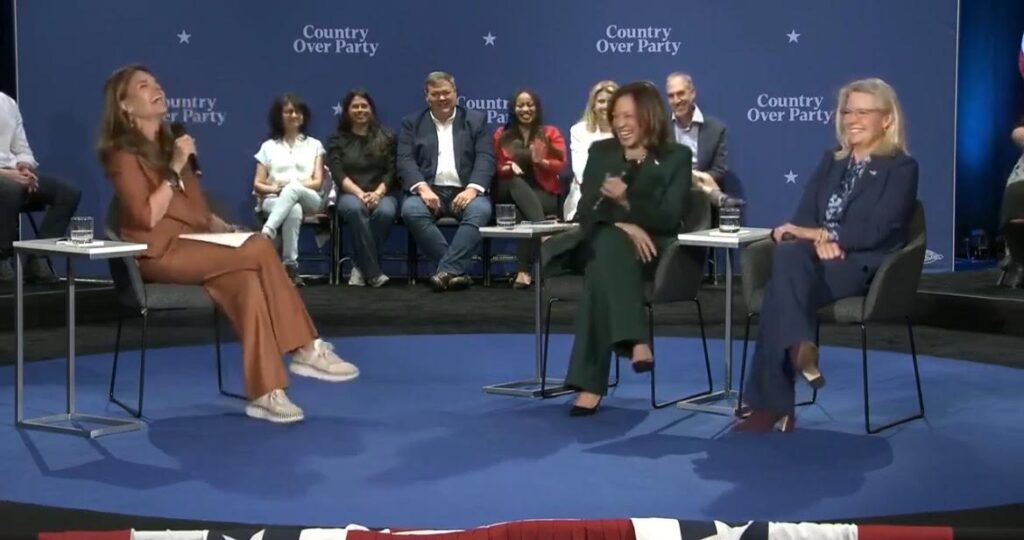Vice President Kamala Harris’s recent collaboration with former Republican Rep. Liz Cheney has raised eyebrows among political pundits and the public alike. Many are questioning the strategy behind such an unexpected alliance, particularly as Harris seems to be reaching out to an audience that traditionally identifies with the Republican Party. The move appears motivated by a desire to attract centrist Republicans and anti-Trump voters amid concerns about the erosion of support within her own party. The Harris campaign may be recognizing that they need to broaden their voter base to regain ground lost in key battleground states like Pennsylvania, Michigan, and Wisconsin, which were crucial during the last presidential election cycle.
In a series of town hall-style discussions, Harris and Cheney targeted suburban voters who previously leaned toward Trump but swung back to support President Joe Biden in the last election. By aligning herself with Cheney, who has positioned herself as a vocal opponent of Trump, Harris aims to appeal to moderate Republicans who might be undecided about their voting intentions. Specifically, the outreach targets supporters of Nikki Haley, the former U.N. Ambassador recognized for her centrist, educated following. This strategy highlights the challenges facing the Harris campaign as they attempt to recapture the moderate voter demographic that fluctuates between the two major parties.
However, the situation is complicated by growing concerns among Democrats over Harris’s ability to connect with working-class voters, particularly those in the Midwest. Many of these voters have not embraced her in the same way they did Biden in the previous election. Notably, key labor organizations that once endorsed Biden, such as the International Brotherhood of Teamsters and the International Association of Fire Fighters, have decided to withhold endorsements in this election cycle. This lack of support underscores the precarious position Harris finds herself in, as strengthening her appeal among centrist Republicans may inadvertently alienate certain factions within her party, especially those that prioritize labor issues.
The decision for Harris to campaign with Cheney also sparks questions about the integrity of partisan identities. While candidates often seek to broaden their appeal across the aisle, this particular partnership has prompted reactions ranging from skepticism to outright disdain among voters and political observers. Some critics mock Harris’s willingness to team up with Cheney, whose lineage includes a controversial legacy due to her father, former Vice President Dick Cheney, often associated with contentious foreign policy decisions and the Iraq War. The juxtaposition of a Democratic vice president sharing a platform with a Republican figurehead has led to perceptions of desperation, raising doubts about the efficacy of such a strategy and whether it can truly bolster Harris’s campaign prospects.
Social media reactions indicate a mixed response from potential voters, with some expressing confusion or even horror at the prospect of Cheney being embraced by Democrats. The comments range from sarcastic reminders of Cheney’s past policy stances to reminders of her familial ties to a revered yet polarizing figure in American history. This indicates that Harris’s attempts to attract more centrist voters could backfire and exacerbate divisions rather than fostering unity. The risk of alienating her base while simultaneously courting Republican voters highlights the delicate balance Harris must navigate in the remaining days leading up to the election.
In conclusion, Harris’s strategic pivot towards centrist Republicans represents a calculated but precarious move in a politically charged environment. While the necessity for support from disaffected Republicans and moderates is clear, the implications of aligning with a figure like Liz Cheney are fraught with potential pitfalls. As the campaign progresses, the effectiveness of this approach remains uncertain. It will be crucial for Harris to find a way to maintain her appeal among traditional Democratic voters while still appealing to the independent and moderate Republicans she seeks to attract. The outcome in the coming days will likely determine the viability of such cross-party alliances and their impact on the broader electoral landscape.

